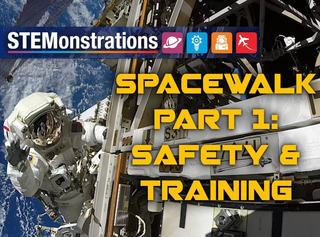
Audience
Educators
Grade Levels
Grades 5-8
Subject
Physical Science, Technology, Forces and Motion, Space Station
Type
Lesson Plans / Activities, Videos
Safety, training and a well-equipped spacesuit are essential components for a spacewalk as astronauts work outside of the space station in low-Earth orbit. Watch Expedition 55/56 flight engineer Ricky Arnold in this two-part episode as he explains spacewalk safety and training in addition to the parts of the spacesuit that protects astronauts outside the space station.
Classroom Connection: Spacewalking
Grade Level: 6-8
Time Required: 55 minutes
Next Generation Science Standards:
MS-PS1-3. Gather and make sense of information to describe that synthetic materials come from natural resources and impact society.
MS-PS1-4. Develop a model that predicts and describes changes in particle motion, temperature, and state of a pure substance when thermal energy is added or removed.
MS-PS2-1. Apply Newton’s Third Law to design a solution to a problem involving the motion of two colliding objects.
MS-PS3-1. Construct and interpret graphical displays of data to describe the relationships of kinetic energy to the mass of an object and to the speed of an object.
MS-PS3-3. Apply scientific principles to design, construct, and test a device that either minimizes or maximizes thermal energy transfer.
MS-PS3-4. Plan an investigation to determine the relationships among the energy transferred, the type of matter, the mass, and the change in the average kinetic energy of the particles as measured by the temperature of the sample.
MS-ETS1-1. Define the criteria and constraints of a design problem with sufficient precision to ensure a successful solution, taking into account relevant scientific principles and potential impacts on people and the natural environment that may limit possible solutions.
MS-ETS1-3. Analyze data from tests to determine similarities and differences among several design solutions to identify the best characteristics of each that can be combined into a new solution to better meet the criteria for success.
MS-ETS1-4. Develop a model to generate data for iterative testing and modification of a proposed object, tool, or process such that an optimal design can be achieved.























